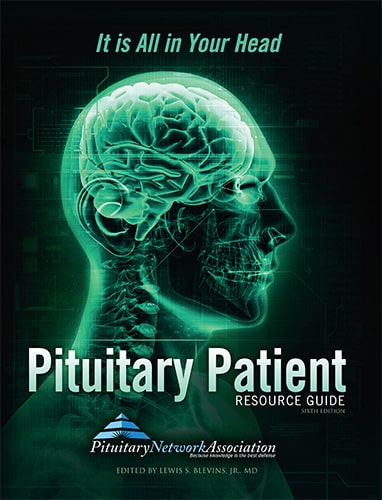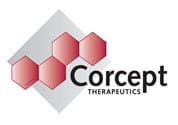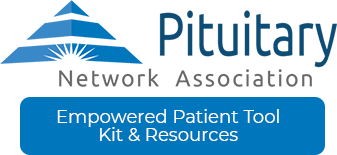Pituitary Glossary starting with P
Pericardial Effusion
Increased amounts of fluid within the sac surrounding the heart, usually due to inflammation.
Pericardial Effusion is an abnormal collection of fluid inside the sac that covers the heart. With pericarditis, the amount of fluid increases within the pericardial layers, squeezes the heart, and can restrict the motion of the heart, called a pericardial effusion.
Pericarditis is usually a complication of viral infections, most commonly echovirus or coxsackie virus, and less frequently, caused by influenza or HIV infection.
Infections with bacteria can lead to bacterial pericarditis (also called purulent pericarditis). Some fungal infections can also produce pericarditis.
PET Scan
Positron Emission Tomography.
A scanning device which uses low-dose radioactive sugar to measure brain activity. This is a limited-use diagnostic tool.
Phenobarbitol®
A sedating medication used to control seizures.
Phenobarbitol is a barbituric acid derivative that acts as a nonselective central nervous system depressant used to control epilepsy seizures and as a sedative to relieve anxiety. It is also used as a short-term treatment for insomnia. Phenobarbital is also known by other names, such as Barbita, Comizial, Gardenale, Fenilcal, Luminal, or Solfoton.
Pituitary Gland
A small oval endocrine gland attached to the brain.
The hypophysis, or pituitary is a small, pea-sized gland located at the base of the brain that functions as “The Master Gland.” From its lofty position above the rest of the body it sends signals to the thyroid gland, adrenal glands, ovaries and testes, directing them to produce thyroid hormone, cortisol, estrogen, testosterone, and many more. These hormones have dramatic effects on metabolism, blood pressure, sexuality, reproduction, and other vital body functions. In addition, the pituitary gland produces growth hormone for normal development of height and prolactin for milk production.
Pituitary Stalk
A tiny structure which connects the hypothalamus to the pituitary gland.
Composed of blood vessels that carry hormones from the brain to the pituitary and also nervous tissue which transports the hormone ADH to the posterior pituitary.
Plaque
A patch of bacteria or tissue cells.
A patch of bacteria or tissue cells.
Posterior
Pertaining to being behind another structure – toward the back of the body.
Posterior pituitary: The back portion of the pituitary, a small gland in the head called the master gland.
The posterior pituitary secretes the hormone oxytocin which increases uterine contractions and antidiuretic hormone (ADH) which increases reabsorption of water by the tubules of the kidney. Underproduction of ADH results in a disorder called diabetes insipidus characterized by inability to concentrate the urine and, consequently, excess urination leading potentially to dehydration. The urine is “insipid” (overly dilute).
Posteroanterior View
View in the direction from the back toward the front.
A term denoting the direction of view or progression, from postanterior to anterior, through a part.
PQCT
Peripheral quantitative computerized tomography.
An imaging technique used to measure body composition.
Primary Amenorrhea
The inability to menstruate, caused by a failure of sexual maturation and function.
Specifically refers to patients who have not ahd any menses whatsoever. Concern arises if menses have not developed prior to age 14. Secondary amenorrhea is loss of menses in a patient who previously had menses.
Primary Brain Tumor
Original source of tumor in the brain rather than other areas of the body.
A primary brain tumor is a mass created by the growth or uncontrolled proliferation of abnormal cells in the brain. The cause of primary brain tumors is unknown. Primary brain tumors may be located in only a small area or spread to nearby areas (invasive), non cancerous (benign) or cancerous (malignant).
Brain tumors are classified depending on the exact site of the tumor, the type of tissue involved, and whether or not it is cancerous. Brain tumors can directly destroy brain cells; or indirectly damage cells by putting pressure on other parts of the brain, leading to swelling and increased pressure within the skull.
Primitive
Undeveloped or in early stages of development, undifferentiated.
Stem cells are primitive precursor cells that are found in most organ systems of the body.
Probe
A surgical instrument for penetrating and exploring bodily passages and cavities.
1) A slender rod of flexible material, with blunt bulbous tip, used for exploring sinuses, fistulas, other cavities, or wounds.
2) A device or agent used to detect or explore a substance; e.g., a molecule used to detect the presence of a specific frag ment of DNA or RNA or of a specific bacterial colony.
3) To enter and explore, as with a probe.
Progesterone
Progesterone
A sex hormone which is made in the ovaries and during pregnancy, by the placenta as well.
Progesterone helps to build up the endometrium during the menstrual cycle.
Prognosis
A forecast as to probable outcome.
A forecast as to probable outcome.









